| Listing 1 - 9 of 9 |
Sort by
|
Book
ISBN: 1498286283 9781498286282 9781498286275 9781498286299 Year: 2016 Publisher: Eugene, Oregon
Abstract | Keywords | Export | Availability | Bookmark
 Loading...
Loading...Choose an application
- Reference Manager
- EndNote
- RefWorks (Direct export to RefWorks)
Violence on television. --- Television and children. --- Children and violence.
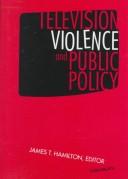
ISBN: 1282594079 9786612594076 0472023284 9780472023288 9780472109036 0472109030 9780472086993 0472086995 0472109030 Year: 2000 Publisher: Ann Arbor University of Michigan Press
Abstract | Keywords | Export | Availability | Bookmark
 Loading...
Loading...Choose an application
- Reference Manager
- EndNote
- RefWorks (Direct export to RefWorks)
Discusses why and how we should rate the content of television programs for violence.
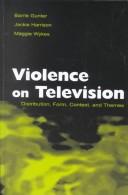
ISBN: 1135653402 1410606902 9781410606907 0203449169 9780203449165 0805837191 9780415172608 9781135653408 9781134691784 9781134691739 9781134691777 9781138986756 9781135653354 9781135653392 9780805837193 9780805846447 1135653399 Year: 2010 Publisher: New York Routledge
Abstract | Keywords | Export | Availability | Bookmark
 Loading...
Loading...Choose an application
- Reference Manager
- EndNote
- RefWorks (Direct export to RefWorks)
Concern about violence on television has been publicly debated for the past 50 years. TV violence has repeatedly been identified as a significant causal agent in relation to the prevalence of crime and violence in society. Critics have accused the medium of presenting excessive quantities of violence, to the point where it is virtually impossible for viewers to avoid it. This book presents the findings of the largest British study of violence on TV ever undertaken, funded by the broadcasting industry. The study was carried out at the same time as similar industry-sponsored research wa
Violence on television. --- Television violence --- TV violence --- Violence in television --- Television --- Telecommunication services --- massamedia --- televisiegeweld
Book
ISBN: 3845224215 3832952748 Year: 2010 Publisher: Nomos Verlagsgesellschaft mbH & Co. KG
Abstract | Keywords | Export | Availability | Bookmark
 Loading...
Loading...Choose an application
- Reference Manager
- EndNote
- RefWorks (Direct export to RefWorks)
Wie Fernsehschaffende
Violence in mass media. --- Violence on television. --- Television violence --- TV violence --- Violence in television --- Television --- Mass media --- Kriminologie: Rechtliche Aspekte --- Strafrecht --- Kriminologie --- Strafvollzug
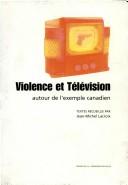

ISBN: 2878541154 2878548817 Year: 2017 Publisher: Paris : Presses Sorbonne Nouvelle,
Abstract | Keywords | Export | Availability | Bookmark
 Loading...
Loading...Choose an application
- Reference Manager
- EndNote
- RefWorks (Direct export to RefWorks)
Le massacre de l'École polytechnique à Montréal en 1989 ou bien encore le meurtre de la jeune Marie-Eve Larivière en 1992 ont fait rebondir le débat sur la violence à la télévision au Canada. Plus d'un million de personnes ont signé, à la suite de ce dernier drame, une pétition réclamant un renforcement du contrôle du contenu des programmes. Quelques faits sordides et sanglants ont eu le même impact sur une société américaine déjà ébranlée par les émeutes de Los Angeles et le revisionnement incessant de lynchages en direct, qu'il s'agisse de l'assassinat de touristes européens en Floride ou du meurtre gratuit du père de Michael Jordan par deux adolescents en Géorgie. Un débat identique se déroule alors aux États-Unis où, au début du mois d'août 1993, producteurs et directeurs de chaînes réunis à Los Angeles tentent d'élaborer un code de bonne conduite visant à réduire l'omniprésence de la violence sur les écrans de télévision américains. En France, le CSA adresse régulièrement des mises en garde aux chaînes, y compris publiques, contre les dérives de la programmation en ce qui concerne la violence et la sexualité.
Violence on television --- Television broadcasting --- Congresses. --- Social aspects --- Telecasting --- Television --- Television industry --- Broadcasting --- Mass media --- Television violence --- TV violence --- Violence in television --- Canada --- télévision --- violence --- VIOLENCE A LA TELEVISION --- CANADA --- CONGRES
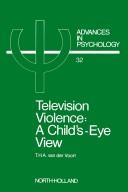
ISBN: 9780080866864 0080866867 9780444879783 0444879781 1281788538 9786611788537 Year: 1986 Publisher: Amsterdam North-Holland
Abstract | Keywords | Export | Availability | Bookmark
 Loading...
Loading...Choose an application
- Reference Manager
- EndNote
- RefWorks (Direct export to RefWorks)
Regional documentation --- United States --- Aggressiveness in children --- Television and children --- Violence on television --- Aggression --- Pediatrics --- Television --- Violence --- Assaultive Behavior --- Atrocities --- Behavior, Assaultive --- Interpersonal Violence --- Structural Violence --- Violent Crime --- Crime, Violent --- Interpersonal Violences --- Violence, Interpersonal --- Violence, Structural --- Violences, Interpersonal --- Violent Crimes --- Biological Warfare --- Riots --- Warfare --- Crime Victims --- Televisions --- Aggressions --- Television violence --- TV violence --- Violence in television --- Aggressiveness (Child psychology) --- Aggressiveness (Psychology) in children --- Child psychology --- Conduct disorders in children --- Violence on television. --- Aggressiveness in children.
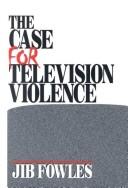
ISBN: 0761907904 0761907890 1322413193 1452220336 1452221677 9781452221670 9780761907909 9780761907909 9780761907893 9781452220338 Year: 1999 Publisher: Thousand Oaks (Calif.): Sage
Abstract | Keywords | Export | Availability | Bookmark
 Loading...
Loading...Choose an application
- Reference Manager
- EndNote
- RefWorks (Direct export to RefWorks)
This text takes the point that TV violence supports the social order by providing a safe outlet for aggressive impulses. Fowles challenges conventional wisdom by asking readers to think about their own viewing habits and those of their friends.
Social problems --- Mass communications --- #SBIB:309H402 --- #SBIB:309H1520 --- #SBIB:309H1016 --- #SBIB:003.AANKOOP --- Media en publiekgroepen: gebruik van de boodschap, effecten van de media, ... --- Radio en/of televisieprogramma’s: algemene werken (functies, genres, taalgebruik, historiek) --- Media: socio-culturele aspecten (massamedia en maatschappij, met inbegrip van cultuurhistorische werken en werken over de maatschappelijke en politieke effecten van de (diverse) media) --- Violence on television. --- Television programs. --- Programs, Television --- Shows, Television --- Television shows --- TV shows --- Television violence --- TV violence --- Violence in television --- Television broadcasting --- Electronic program guides (Television) --- Television scripts --- Television --- Violence on television --- Media en publiekgroepen: gebruik van de boodschap, effecten van de media, .. --- Media en publiekgroepen: gebruik van de boodschap, effecten van de media, . --- Media en publiekgroepen: gebruik van de boodschap, effecten van de media,
Book
ISBN: 3319644599 3319644580 Year: 2017 Publisher: Cham : Springer International Publishing : Imprint: Palgrave Macmillan,
Abstract | Keywords | Export | Availability | Bookmark
 Loading...
Loading...Choose an application
- Reference Manager
- EndNote
- RefWorks (Direct export to RefWorks)
This book undertakes a concentrated study of the impact of degraded and low-quality imagery in contemporary cinema and real-world portrayals of violence. Through a series of case studies, the book explores examples of corrupted digital imagery that range from mainstream cinema portrayals of drone warfare and infantry killing, through to real-world recordings of terrorist attacks and executions, as well as perpetrator-created murder videos live-streamed on the internet. Despite post-modernist concerns of cultural inurement during the seminal period of digitalized and virtualized killing in the 1990s, real-world reactions to violent media indicate that our culture is anything but desensitized to these media depictions. Against such a background, this book is a concentrated study of how these images are created and circulated in the contemporary media landscape and how the effect and affect of violent material is impacted by the low-resolution aesthetic. Stuart Marshall Bender is an Early Career Research Fellow at Curtin University, Australia, exploring the digital aesthetics of violence. A scholar and filmmaker, he has published work in The Journal of Popular Film & Television, M/C Journal, First Monday and had films screened in competition at a range of international festivals.
Violence on television. --- Television violence --- TV violence --- Violence in television --- Television --- Film genres. --- Communication. --- Motion pictures. --- Culture-Study and teaching. --- Genre. --- Media and Communication. --- Film Theory. --- Close Reading. --- Cultural Theory. --- Cinema --- Feature films --- Films --- Movies --- Moving-pictures --- Audio-visual materials --- Mass media --- Performing arts --- Communication, Primitive --- Mass communication --- Sociology --- Genre films --- Genres, Film --- Motion picture genres --- Motion pictures --- History and criticism --- Plots, themes, etc. --- Culture—Study and teaching.
Book
ISBN: 9780857739087 0857739085 9780857725448 0857725440 9781786724434 178672443X 1784530441 9781784530440 9781784534097 1784534099 0755604342 0755603672 1780768966 1786734435 9781786734433 9781350229174 Year: 2019 Publisher: London, England : [London, England] : I.B. Tauris, Bloomsbury Publishing,
Abstract | Keywords | Export | Availability | Bookmark
 Loading...
Loading...Choose an application
- Reference Manager
- EndNote
- RefWorks (Direct export to RefWorks)
"Concentrationary Memories has, as its premise , the idea at the heart of Alain Resnais's film Night and Fog (1955) that the concentrationary plague unleashed on the world by the Nazis in the 1930s and 1940s is not simply confined to one place and one time but is now a permanent presence shadowing modern life. It further suggests that memory (and, indeed art in general) must be invoked to show this haunting of the present by this menacing past so that we can read for the signs of terror and counter its deformation of the human. Through working with political and cultural theory on readings of film, art, photographic and literary practices, Concentrationary Memories analyses different cultural responses to concentrationary terror in different sites in the post-war period, ranging from Auschwitz to Argentina. These readings show how those involved in the cultural production of memories of the horror of totalitarianism sought to find forms, languages and image systems which could make sense of and resist the post-war condition in which, as Hannah Arendt famously stated 'everything is possible' and 'human beings as human beings become superfluous.' Authors include Nicholas Chare, Isabelle de le Court, Thomas Elsaesser, Benjamin Hannavy Cousen, Matthew John, Claire Launchbury, Sylvie Lindeperg, Laura Malosetti Costa, Griselda Pollock, Max Silverman, Glenn Sujo, Annette Wieviorka and John Wolfe Ackerman."--
Violence in motion pictures. --- Violence in moving-pictures --- Motion pictures --- Violence --- Violence in popular culture. --- Popular culture --- Moral and ethical aspects. --- Moral and religious aspects --- Violence on television. --- Television violence --- TV violence --- Violence in television --- Television --- Holocaust, Jewish (1939-1945), in motion pictures. --- Memory in motion pictures. --- World War, 1939-1945 --- Film theory & criticism --- Aesthetics. --- Motion pictures and the war. --- Resnais, Alain, --- Criticism and interpretation. --- Nuit et brouillard (Motion picture) --- World War, 1939-1945, in motion pictures --- Aesthetics --- Resnais, Alain --- Nacht und Nebel (Motion picture) --- Night and fog (Motion picture) --- Nacht en nevel (Motion picture) --- Au cinéma. --- Au cinéma.
| Listing 1 - 9 of 9 |
Sort by
|

 Search
Search Feedback
Feedback About UniCat
About UniCat  Help
Help News
News